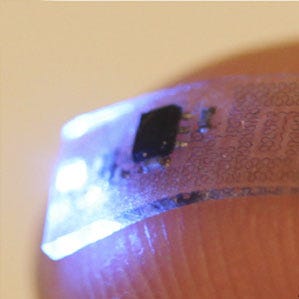An Implantable LED to Take Your Pain Away
December 4, 2015
A new flexible, biocompatible optogenetic device could help researchers better understand the neurological basis of pain, and potentially help provide relief for patients suffering from chronic pain.
|
A wireless LED to implant in mice (Image courtesy of Nature Biotechnology) |
Kristopher Sturgis
Chronic pain remains as difficult to understand as it is to treat for both doctors and patients who work to understand the source and cause of pain in the body. Recently, researchers from Washington University in St. Louis and the University of Illinois at Urbana-Champaign collaborated to develop a implantable electronic device that could be used to illuminate and manipulate neural circuits that are known to create the perception of pain through optogenetics.
"For now this is mainly a discovery tool for research," says John Rogers, professor of materials science and engineering at the University of Illinois at Urbana-Champaign and co-creator of the device. "The technology requires optogenetic modification of the animal to induce light sensitivity in the peripheral nerves and spinal cord. Many researchers are working on genetic approaches to the same outcome for use in humans, but these are still ongoing."
Optogenetics is an emerging biological technique that involves the use of light to control cells or neurons in living tissue. This new implantable device features a wirelessly activated light-emitting diode (LED) that can be used trigger neurons to fire in genetically modified subjects, or be blocked from firing, all through the use of light.
In years past, similar technologies relied on external light sources that limited the targetable circuits to areas of the body where a rigid fiber-optic cable could be held in place. However, this new wireless device was created with thin, soft materials that contain mechanical properties similar to that of biological tissue. This means that it doesn't need to be stuck to bone, allowing scientists to gain a better understanding of the neural activity in the peripheral nervous system and spinal cord.
"The device allows completely new types of studies into the physiology of pain responses, in ways that were previously impossible with the kind of fiber optic hardware and tethers that have been used in the past," Roger says. "We can now study multiple animals simultaneously, over long periods of time, both in isolation or in social interactions. All in complex three dimensional environments."
Rogers teamed up with Robert Gereau, a professor of anesthesiology and director of the pain center at Washington University in St. Louis to develop the micro-LED implantable and observe its influence on brain activity in mice. In their proof-of-concept experiments, they were able to show that by shining the light on groups of neurons that were modified to be light-sensitive, they were able to modify behaviors associated with pain.
The group believes that this new technology could provide a platform for exploration into some long-standing questions that surround how sensory information is processed in the spinal cord, and help identify the role of specific neurons that are thought to be involved with pain. They believe that a better understanding could lead to new pain therapies, and this device could even be used as a part of the healing process.
"We believe that the basic hardware and wireless strategies can be adapted for delivery of voltage and current pulses directly," Rogers says. "In this case, the technology might be useful for nerve stimulation using electrical pulses. In the future, it might be possible to use genetic modification to create optogenetic responses in humans, in which case the light emitting functionality could be used directly as a therapy."
Learn more about cutting-edge medical devices at MD&M West, February 9-11 at the Anaheim Convention Center in Anaheim, CA. |
Kristopher Sturgis is a contributor to Qmed and MPMN.
Like what you're reading? Subscribe to our daily e-newsletter.
About the Author(s)
You May Also Like



